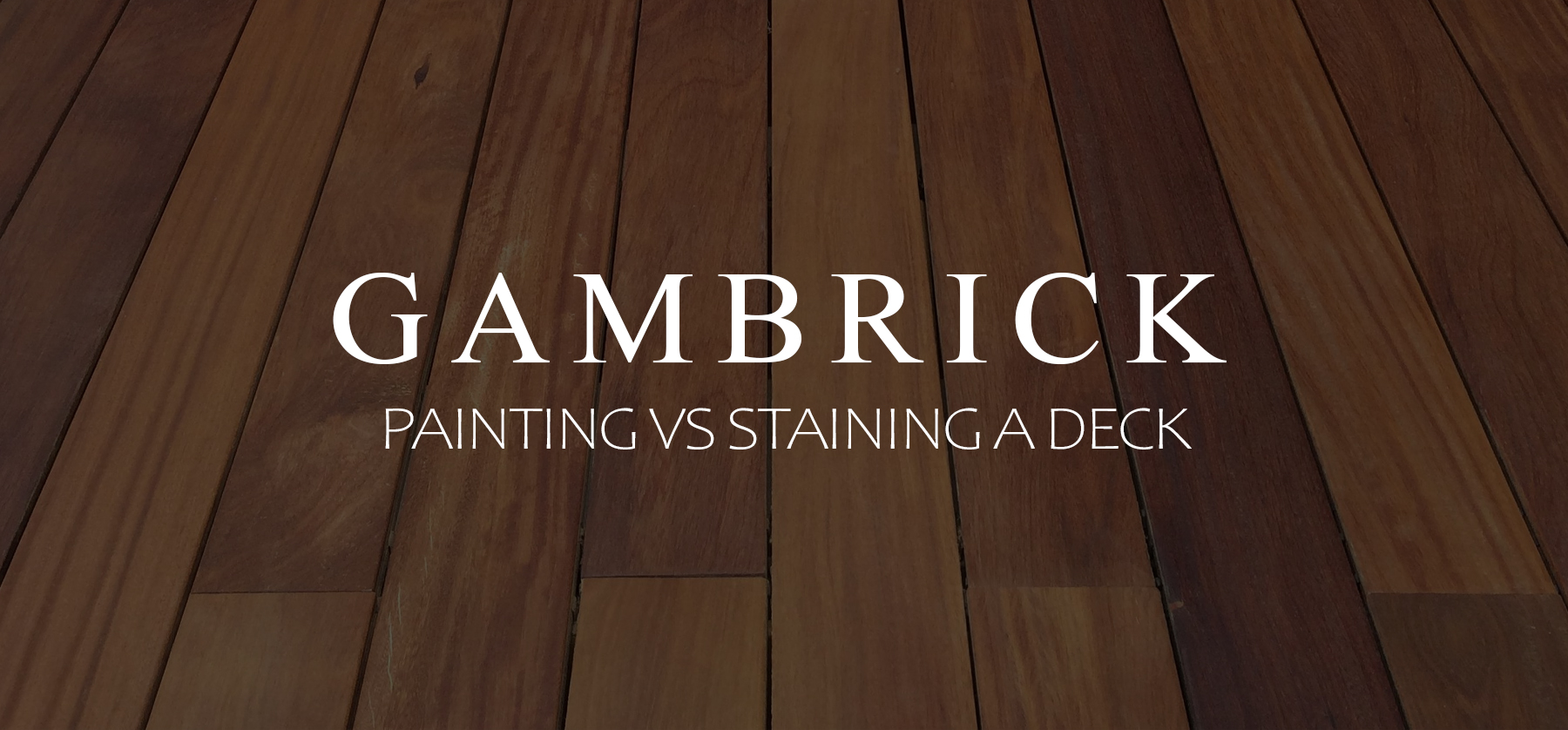Painting Vs Staining A Deck
Painting vs staining a deck. Both are great ways to protect decks against weather damage. They’ve very similar materials applied in much the same way and for basically the same purpose. But for all their similarities, paint and stain are very different. There are quite a few factors to consider and each has it’s own pros and cons. Stain is cheaper than paint but has a lot less variety when it comes to color. Although paint comes in thousands of colors, the look is unnatural which is why some people prefer stain. They want some of that beautiful wood grain to show through. Stain is easier to apply but doesn’t last as long which means reapplications. Paint has to be reapplied eventually too but it’s easier to maintain.
So which one is best? It’s hard to say because they’re different materials used for a different purpose. If you want a more natural wood grain look then stain is the way to go. However if you want more color choices then opt for paint. On a budget, stain is cheaper and easier to apply, but it doesn’t last as long and is harder to maintain. Paint tends to protect better because it’s thicker but the look is artificial.
Ahead we’ll look at painting vs staining a deck in more detail. Which is best is really up to you and what you want to get out of the material.
Painting Your Deck: Pros
There are plenty of reasons why you should choose paint to color and protect your deck. Here are a few of the pros.
Variety. Paint comes in thousands of colors and almost all of them can be made into an exterior paint. This makes monochromatic color scheme much easier to pull off since you can match just about anything. Stain on the other hand only comes in a few colors so color options are a big advantage for paint vs staining a deck.
Paint Is Opaque. Since paint is opaque, which means a solid color that can’t be seen through, you can cover up flaws with it. This can be a big advantage if your deck is older and has discoloring. Most stains are thin. They’re meant to be seen through which brings out the natural wood grain. But if you have discoloring those colors will comes through too and sometimes can actually be amplified.
Long Lasting. A good paint job can last 10+ years which is a huge plus for paint vs staining a deck. Stain generally needs to be reapplied every year. This all varies based on the stain or paint you use and weather conditions. But in general paint lasts years longer than stain. For homeowners that don’t want maintenance this is a big plus.
Painting Your Deck: Cons
Although painting is a great way to color and protect a deck, there are a few cons.
Unnatural Looks. Wood is a beautiful material. Especially if you have a more exotic hardwood like Teak or Ipe. Paint is totally opaque so all that beauty, warmth and charm will be lost. This is why we primarily see decks painted when they’re older or made from a cheaper material like pine.
Trapped Moisture. When you paint your deck, moisture can get locked in by the paint. Wood decking needs to be very dry before you paint it. If water gets trapped in by the paint it will try to get out. This can cause peeling, bubbles and chips.
Deck Paint Is Permanent. Once you paint a deck it will probably be a painted deck forever. There are way to strip the paint but it’s very labor intensive and doesn’t always work. Also the stripping process can damage the wood.
Cost. Painting a deck isn’t cheap. On top of the paint you need to treat the wood first and the prime it. There are a lot of steps to follow. Stain is cheaper and easier.
Staining Your Deck: Pros
Another great way to color and protect your deck is stain. It’s very similar to paint and accomplishes much the same things but has a very different look. It’s also easier to apply and cheaper than deck paint.
Options. Use a clear wood stains if you want to show off the natural beauty of your wood without adding color. Most clear stains can enhance the woods natural color by making the grain appear darker. If you want a little extra color then use a tinted wood stain. They’re translucent so you can still see the wood’s grain but with a little more color. If you like the opaque look of paint but want to use a stain then go with opaque. Many wood stains have lots of pigment which mimics the look of paint.
Accentuate The Wood. Stain is better than deck paint if you want to accentuate and highlight the wood look. This is especially beautiful with hardwoods like Ipe. A protective stain will help keep the woods natural color and prevent greying.
Stain Is Easy To Apply. Stain is easier to apply than deck paint and there are less steps involved.
Cost. Deck stain is cheaper than deck paint.
Control. Paint is opaque. When you paint a deck you lose the wood look entirely. However with stain you can control the opacity and bring out as much wood grain and color as you like.
Staining Your Deck: Cons
Although deck stain is a great option for many people, it’s not for everyone.
Reapplication. Most stains don’t last that long. Typically we reapply deck stain every year here in New Jersey because we see hot summer and cold winters. The stains just don’t last long. The more pigment you use the longer the stain tends to last but I like an almost clear deck stain.
Cracks. Paint is thick and fills in all the small cracks and pores. Stain is very thin so it doesn’t offer that extra protection.
Flaws. If your deck has flaws or discolorations, an opaque paint can cover them up and in some cases fill them in. Stains typically can’t do this unless you go with something very opaque like a paint. And in that case paint may be a better option.
Deck Paint Lasts Longer Than Stain
Both paint and stain deck finishes have there problems and don’t last forever. Deck paint is thicker and prone to chipping or peeling while stain is thinner and discolors. But when comparing painting vs. staining a deck, paint is generally the winner in terms of longevity. It’s a thicker and more durable coloring. Especially if you use a good quality paint with some UV protection built in. The color will remain bold for longer and shouldn’t chip.
A good quality deck paint can easily last 10 years or longer before requiring reapplication. There’s no stain that can match that type of coverage or protection. Typically most deck stains need to be reapplied every year or so.
- Oil-based deck paints offer the best protection against moisture which is the leading cause of damage. If you live in a very wet area then oil based paints are worth considering.
- Latex paints provide the best defense against UV sun damage and fading.If you live in a very hot and sunny area then latex paints may be better for your deck.
Deck stains are more short-lived compared to paints generally lasting from one to eight years before requiring re-application. Typically, the more pigment that’s in the stain the more resistant it is to moisture and UV damage. This is mainly due to the pigments being more opaque. The thicker the color the more sun and moisture it blocks.
Transparent deck stains provide lower moisture protection and almost no UV protection. Solid stains offer higher moisture and UV protection but generally not as much as paint unless you buy a 100% opaque stain.
Deck Paint Is Easier To Maintain
Deck paint dries to a durable clean surface that makes sweeping away dust, dirt, and debris easy.It’s generally thicker than paint and offers some amount of coating. Paint will penetrate into small cracks and pores which leaves the surface smoother and easier to clean. It also comes in a variety of sheen options which offer even more protection.
Stain dries to a more matte finish and isn’t as thick as paint so it doesn’t fill all the small cracks and pores as well. It also doesn’t really offer a layer of protective coating like paint. Because of this it takes more effort to sweep and clean the surface because it’s rougher and has more pores.
Many people will use a pressure washer on a stained deck because they’re harder to clean. This is a bad idea because too much pressure can damage the wood. If you do use one, make sure to start on a low setting. Especially if your deck is older. The maximum pressure setting shouldn’t exceed 600 psi for softwoods or 1500 psi for hardwoods.Contrast this with a painted deck that can easily be cleaned with a house mop or sponge.
At least once a year you should deep clean the deck. This removes any bacteria or mold growing on the surface. This involves applying a deck cleaner by sprayer or roller, scrubbing down especially dirty spots with a soft brush, and then rinsing with a hose.
Touch ups are much easier with deck paint too. Since it’s opaque you can simply paint over any stain. This is much harder with stain because they’re generally translucent so the stain will just show through no matter how many times you stain over it.
Can You Stain Over Paint?
Yes, you can apply a deck stain over a painted deck. However if you use a translucent stain the old paint will show through. Because of this, most people opt for an opaque stain. So in that case why not just use paint instead. You’ll get more color choices and more protection with less maintenance.
The benefits to staining over an old painted deck are price and ease. Stain tends to be cheaper than paint, even when you use an opaque one. And they’re typically easier to apply because deck stains are thinner than deck paints.
One other benefit to applying deck stain over old paint is the added protection you retain from the paint. Weather and UV rays will not only have to penetrate the new stain but also the old paint layer. This can add double protection for the wood.
I’d recommend cleaning up the old paint before you apply new deck stain. Clan the paint really well and remove and cracked or chipping paint. It’s better to stain a clean and dry surface than one that’s dirty because you’ll lock in the issues with new stain. There may also be some problems with adherence to the surface if it’s dirty.
If you want to stain an old painted deck but don’t want the old paint then that takes some effort. Converting from a painted deck to a stained one requires completely stripping the old paint and primer with either commercial paint stripper or sandpaper. Then cleaning deck entire surface with a deck cleaner, sanding imperfections, and then applying the stain. It’s a lot of work to remove all that paint and often isn’t possible. Generally there will be some stubborn cracks or pores that just won’t come clean.
Deck Stain Is Easier To Apply Than Paint
Both painting and staining the deck will require prep work before you start. The surface should first be swept clean of any dust and dirt. Once that’s done, scrub the deck with a store bought or homemade deck cleaner. Use a soft brush to clean any stubborn areas or cracks. Repair or replace damaged boards before you apply either stain or paint. Lightly sand any ridges or damaged areas to make them smooth.
Once the surface is prepared and fully dry, stain can be applied by brush or roller in a single coat. Stain is watery so it resists pooling and its transparency minimizes the appearance of overlap marks.
If you use a two in one deck stain and sealer there’s no need for an additional clear top coat. This makes things go even faster.
Painting a deck is a little different than staining one. The surfaces you’ll be painting should first be treated with wood preservative and then coated with a quality primer. Using a primer first not only helps protect the wood but also saves money because primer is cheaper than deck paint. Two coats of latex or oil based paint is usually best. Use multiple thin coats rather than trying to cover with one thick one.
Since paint is so much thicker than stain, globs and overlap marks can happen. This is another reason to use thin coats.
Once the deck is fully painted and dry, the surface should be sealed with a clear polyurethane sealer.
Deck Paint Has More Variety
Deck paint is available in thousands of colors. Just about any color you can imaging can be mixed for exterior use. This can be a big benefit if you want a specific look or are trying to coordinate your color scheme.
Wood stain is typically designed to accentuate the natural colors of the wood it’s applied to. You don’t have nearly the amount of variety as you do with paint and most colors are in the brown family. Most deck stains come translucent with very little pigment so you can see the wood grain. Although there are deck stains with more pigment that are opaque. I never understood the benefit of using an opaque deck stain though. If you don;t want to see the wood grain then I prefer the added protection, durability and variety of colors deck paint offers.
Deck Stain Is A More Natural Look
When comparing deck painting vs staining, you need to decide what look you like best. Paint has more variety and bolder colors but deck stains have a more natural look as long as you choose a stain that’s translucent.
Wood stains that are transparent to semi solid in opacity, partially fill the pores and small cracks of wood. They form a very thin layer over the deck that lets the natural grain pattern and wood colors show through. Most stains work with the color of the wood and do not completely cover it up like paint does. Because some of the wood is shown through the stain, it’s a much more natural look.
Paint is thicker with a lot more pigment than stain. It fully fills the pores and small cracks of the wood and dries to an opaque surface. The surface is generally smoother, more polished, bolder, and more artificial. Since none of the wood grain or coloring shows through paint the surface looks fake like a plastic.
A good middle ground is high pigment stain. It isn’t totally opaque which means you’ll still see a bit of natural wood color and grain show through but it’s thicker and offers more protection than translucent stains.
Deck Stain Is Cheaper Than Paint
Deck stain typically costs between $20 and $35 per gallon. Exterior deck paint generally ranges from $40 to $65+ per gallon.Depending on the brand and quality paint you use it could get expensive.
Also keep in mind that you’ll also have to pay an extra $15 to $40 per gallon for a wood preservative and $15 to $30 per gallon for primer.
Most good quality wood stains contain a preservative so you don’t have to do it separately.
Then there’s all the labor to consider. Painting a deck requires a separate preservative coat and priming. You can skip those steps when staining the deck.
Deck stain also goes on much easier than paint because it’s so thin. This saves even more time and money.
There’s only one way paint gets cheaper than stain and that’s over time. Paint is more durable and can go 10 years without needing reapplication. Contrast that with deck stain that can need a new coat every year.
Summary: Painting Vs Staining A Deck
Painting vs staining a deck. Both are great ways to protect decks against weather damage. They’ve very similar materials applied in much the same way and for basically the same purpose. But for all their similarities, paint and stain are very different. There are quite a few factors to consider and each has it’s own pros and cons. Stain is cheaper than paint but has a lot less variety when it comes to color. Although paint comes in thousands of colors, the look is unnatural which is why some people prefer stain. They want some of that beautiful wood grain to show through. Stain is easier to apply but doesn’t last as long which means reapplications. Paint has to be reapplied eventually too but it’s easier to maintain.
So which one is best? It’s hard to say because they’re different materials used for a different purpose. If you want a more natural wood grain look then stain is the way to go. However if you want more color choices then opt for paint. On a budget, stain is cheaper and easier to apply, but it doesn’t last as long and is harder to maintain. Paint tends to protect better because it’s thicker but the look is artificial.
Ahead we’ll look at painting vs staining a deck in more detail. Which is best is really up to you and what you want to get out of the material.
If you have any questions or comments about painting or staining a deck E-mail any time.





















